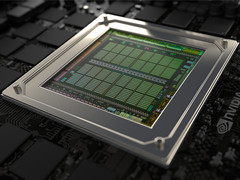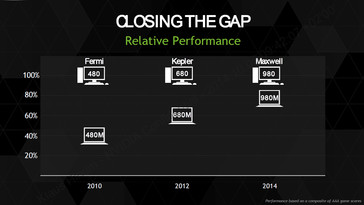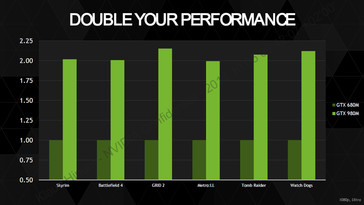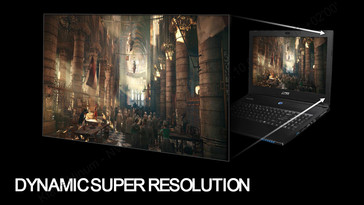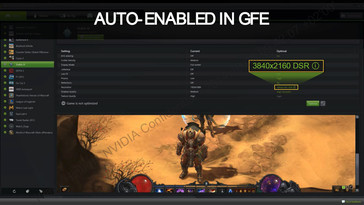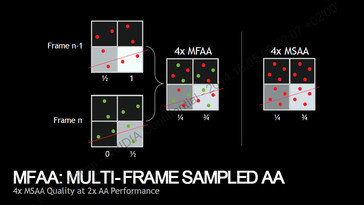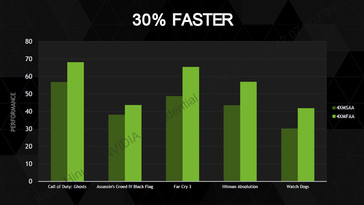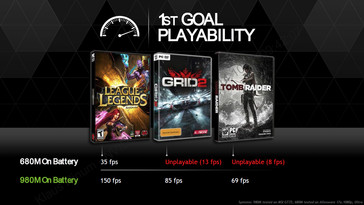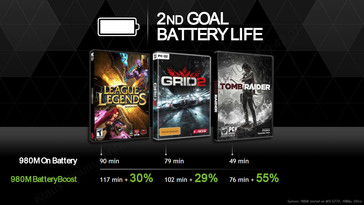Power consumption is the most crucial criterion of high-end mobile graphics cards. Even large DTR notebooks with powerful cooling have difficulty coping with 100 Watt GPUs, so clock rates and performance of mobile graphics solutions are noticeably lower than their desktop counterparts.
This should change with Nvidia's GeForce GTX 970M and GTX 980M. Unveiled today and only a few weeks after the announcement of the desktop models (GTX 970 and GTX 980), the Maxwell chip GM204 praised for its efficiency is now available in the mobile range. Certainly, Nvidia wants to win the performance crown. As usual, we will first cover the technical data of the new GPUs:
| GeForce GTX 980M | GeForce GTX 970M | GeForce GTX 880M | GeForce GTX 870M | GeForce GTX 980 (Desktop) | GeForce GTX 970 (Desktop) | |
|---|---|---|---|---|---|---|
Lithography |
28 nm | 28 nm | 28 nm | 28 nm | 28 nm | 28 nm |
Architecture |
Maxwell (GM204) | Maxwell (GM204) | Kepler (GK104) | Kepler (GK104) | Maxwell (GM204) | Maxwell (GM204) |
ALUs |
1536 | 1280 | 1536 | 1344 | 2048 | 1664 |
Core Clock |
1038 MHz + Boost | 924 MHz + Boost | 954 MHz + Boost | 941 MHz + Boost | 1126 MHz + Boost | 1050 MHz + Boost |
Memory interface |
256 Bit (GDDR5) | 192 Bit (GDDR5) | 256 Bit (GDDR5) | 192 Bit (GDDR5) | 256 Bit (GDDR5) | 256 Bit (GDDR5) |
Memory capacity |
up to 8 GB | up to 6 GB | up to 8 GB | up to 6 GB | 4 GB | 4 GB |
Memory clock (eff.) |
1250 MHz (5000 MHz) | 1250 MHz (5000 MHz) | 1250 MHz (5000 MHz) | 1250 MHz (5000 MHz) | 1750 MHz (7000 MHz) | 1750 MHz (7000 MHz) |
DirectX |
11.2 | 11.2 | 11.0 | 11.0 | 11.2 | 11.2 |
On paper, the specs appear to be rather modest compared to the previous GeForce GTX 880M and 870M: Although the clock rates of the GTX 900M series are sightly higher, the activate shader units remain unchanged or even slightly lower in the case of the GTX 970M. Is this a bad omen for performance? No: The new GPUs should still benefit from their essentially revised architecture. For example, Nvidia restructured the streaming multi processors (SMM) in Maxwell to contain only 128 shader units and 8 TMUs (compared to 192 shader units and 16 TMUs in Kepler). Together with further optimizations, the GM204 should perform about 35 to 40 percent better than its Kepler GK104 predecessor with the same number of ALUs.
Changes in the memory interface have been primarily to increase energy efficiency. Nvidia increased neither the bus size nor the clock rate, but instead integrated larger L1 and L2 caches and better compression algorithms to increase effective bandwidth. The manufacturer promises double the performance of the GeForce GTX 680M in this regard. As both are processed in a 28 nm lithography, this is certainly impressive.
First benchmarks run by Nvidia, prove a notable performance gain of the GTX 900M series. In the Fire Strike test of 3DMark (2013), the GeForce GTX 980M and GTX 970M took the lead among current single GPU solutions. They are 50 and 20 percent faster than the GTX 880M.
| 3DMark - 1920x1080 Fire Strike Graphics (sort by value) | |
| GeForce GTX 880M SLI | |
| Radeon R9 M290X Crossfire | |
| GeForce GTX 780M SLI | |
| GeForce GTX 980M | |
| GeForce GTX 880M | |
| GeForce GTX 780M | |
| Radeon R9 M290X | |
The difference is slightly smaller in games. In our tests with a GTX 970M-equipped Schenker XMG P505, our gaming benchmarks resulted in a 10 % lead compared to the GTX 880M and a 40 % lead compared to the GTX 870M. Stay tuned for our complete review of the Schenker XMG P505.
| Middle-earth: Shadow of Mordor - 1920x1080 Ultra Preset (HD Package) (sort by value) | |
| GeForce GTX 970M (344.00) | |
| GeForce GTX 880M (mixed driver) | |
| GeForce GTX 870M (mixed driver) | |
| Radeon R9 M290X (mixed driver) | |
| Fifa 15 - 1920x1080 High Preset AA:4x MS (sort by value) | |
| GeForce GTX 970M (344.00) | |
| GeForce GTX 880M (mixed driver) | |
| GeForce GTX 870M (mixed driver) | |
| Radeon R9 M290X (mixed driver) | |
| Sims 4 - 1920x1080 Ultra Preset (sort by value) | |
| GeForce GTX 970M (344.00) | |
| GeForce GTX 880M (mixed driver) | |
| GeForce GTX 870M (mixed driver) | |
| Radeon R9 M290X (mixed driver) | |
| Risen 3: Titan Lords - 1920x1080 Ultra/High, On AF:16x (sort by value) | |
| GeForce GTX 970M (344.00) | |
| GeForce GTX 880M (mixed driver) | |
| GeForce GTX 870M (mixed driver) | |
| Radeon R9 M290X (mixed driver) | |
| GRID: Autosport - 1920x1080 Ultra Preset AA:4x MS (sort by value) | |
| GeForce GTX 970M (344.00) | |
| GeForce GTX 880M (mixed driver) | |
| GeForce GTX 870M (mixed driver) | |
| Radeon R9 M290X (mixed driver) | |
| Watch Dogs - 1920x1080 Ultra Overall Quality, Ultra Textures AA:4x MS (sort by value) | |
| GeForce GTX 970M (344.00) | |
| GeForce GTX 880M (mixed driver) | |
| GeForce GTX 870M (mixed driver) | |
| Wolfenstein: The New Order - 1920x1080 Ultra Preset (sort by value) | |
| GeForce GTX 970M (344.00) | |
| GeForce GTX 880M (mixed driver) | |
| GeForce GTX 870M (mixed driver) | |
| Thief - 1920x1080 Very High Preset AA:FXAA & High SS AF:8x (sort by value) | |
| GeForce GTX 970M (344.00) | |
| GeForce GTX 880M (332.35) | |
| GeForce GTX 870M (332.35) | |
| Radeon R9 M290X (13.151.0.0) | |
| Call of Duty: Ghosts - 1920x1080 Extra / High / HBAO+ / No dynamic fur AA:4x MS (sort by value) | |
| GeForce GTX 970M (344.00) | |
| GeForce GTX 880M (332.35) | |
| GeForce GTX 870M (332.35) | |
| Radeon R9 M290X (13.151.0.0) | |
| Battlefield 4 - 1920x1080 Ultra Preset AA:4x MS (sort by value) | |
| GeForce GTX 970M (344.00) | |
| GeForce GTX 880M (332.35) | |
| GeForce GTX 870M (332.35) | |
| Radeon R9 M290X (13.151.0.0) | |
| Saints Row IV - 1920x1080 Ultra Preset AA:8x MS AF:16x (sort by value) | |
| GeForce GTX 970M (344.00) | |
| GeForce GTX 880M (332.35) | |
| GeForce GTX 870M (332.35) | |
| Radeon R9 M290X (13.151.0.0) | |
| Metro: Last Light - 1920x1080 Very High (DX11) AF:16x (sort by value) | |
| GeForce GTX 970M (344.00) | |
| GeForce GTX 880M (332.35) | |
| GeForce GTX 870M (332.35) | |
| Radeon R9 M290X (13.151.0.0) | |
| BioShock Infinite - 1920x1080 Ultra Preset, DX11 (DDOF) (sort by value) | |
| GeForce GTX 970M (344.00) | |
| GeForce GTX 880M (332.35) | |
| GeForce GTX 870M (332.35) | |
| Radeon R9 M290X (13.151.0.0) | |
| Tomb Raider - 1920x1080 Ultra Preset AA:FX AF:16x (sort by value) | |
| GeForce GTX 970M (344.00) | |
| GeForce GTX 880M (332.35) | |
| GeForce GTX 870M (332.35) | |
| Radeon R9 M290X (13.151.0.0) | |
| Crysis 3 - 1920x1080 Very High Preset AA:2xSM AF:16x (sort by value) | |
| GeForce GTX 970M (344.00) | |
| GeForce GTX 880M (332.35) | |
| GeForce GTX 870M (332.35) | |
| Radeon R9 M290X (13.151.0.0) | |
| Far Cry 3 - 1920x1080 DX11 Ultra Preset (HDAO, Enhanced Alpha To Coverage) AA:4x MS (sort by value) | |
| GeForce GTX 970M (344.00) | |
| GeForce GTX 880M (332.35) | |
| GeForce GTX 870M (332.35) | |
| Radeon R9 M290X (13.151.0.0) | |
| Hitman: Absolution - 1920x1080 Ultra Preset AA:4xMS AF:16x (sort by value) | |
| GeForce GTX 970M (344.00) | |
| GeForce GTX 880M (332.35) | |
| GeForce GTX 870M (332.35) | |
| Radeon R9 M290X (13.151.0.0) | |
| Guild Wars 2 - 1920x1080 All Maximum / On AA:FX (sort by value) | |
| GeForce GTX 970M (344.00) | |
| GeForce GTX 880M (332.35) | |
| GeForce GTX 870M (332.35) | |
In principle, the Maxwell architecture has already been available for notebooks in the form of the GM107 or GeForce GTX 860M. However, the larger GM204 with its 5.2 billion transistors and 398 mm² die size is a higher-end model, which not only offers more processing units, but also some new features and tweaks. Certainly, the most important change is that it completely supports the current DirectX 11.2 standard. Previously, only a few AMD models have done so. It is likely that the GM204 is already compatible with DirectX 11.3 and DirectX 12, but we cannot confirm just yet since the two versions are not currently finalized.
Also new is the implementation of DSR (Dynamic Super Resolution) and an innovative anti-aliasing mode called MFAA. DSR utilizes extremely high resolutions - higher than the native pixel count of the display - to improve the picture in a manner similar to superscaling. Furthermore, it should also set new standards in image quality thanks to its configurable Gauss filter. In contrast, MFAA improves performance: by changing the sample order between single frames, images should look subjectively similar between 4x MFAA and 4x MSAA, but with the performance penalty of 2x MSAA. Unfortunately, both features will only become available after a future driver update.
Nvidia's Battery Boost technology has been available since the launch of the GTX 800M series and continues to improve. In cooperation with notebook manufacturers, the available battery capacity can be dynamically distributed between the CPU and GPU, which should increase battery life. Otherwise, the basic procedure remains the same: Clock rates and voltages of both the CPU and GPU can be decreased via Nvidia settings and by limiting the frame rate to lower power consumption. Battery life can increase by up to 50 percent for older games with lower hardware requirements.
As usual, Nvidia does not publish official prices for the new GPUs. However, it is unlikely that the GeForce GTX 980M and the GTX 970M are cheaper than its direct predecessors. Among other manufacturers, Asus (G751), MSI (GT72, GS60, GS70), Gigabyte (P35, Aorus X7) and Clevo (P150, P650) are some of the major launch partners. These models will start shipping soon with 970M/980M GPUs and additional manufacturers and models will follow in the coming weeks and months. We will publish our first experiences and reviews in just a few days.
Source(s)
Nvidia


